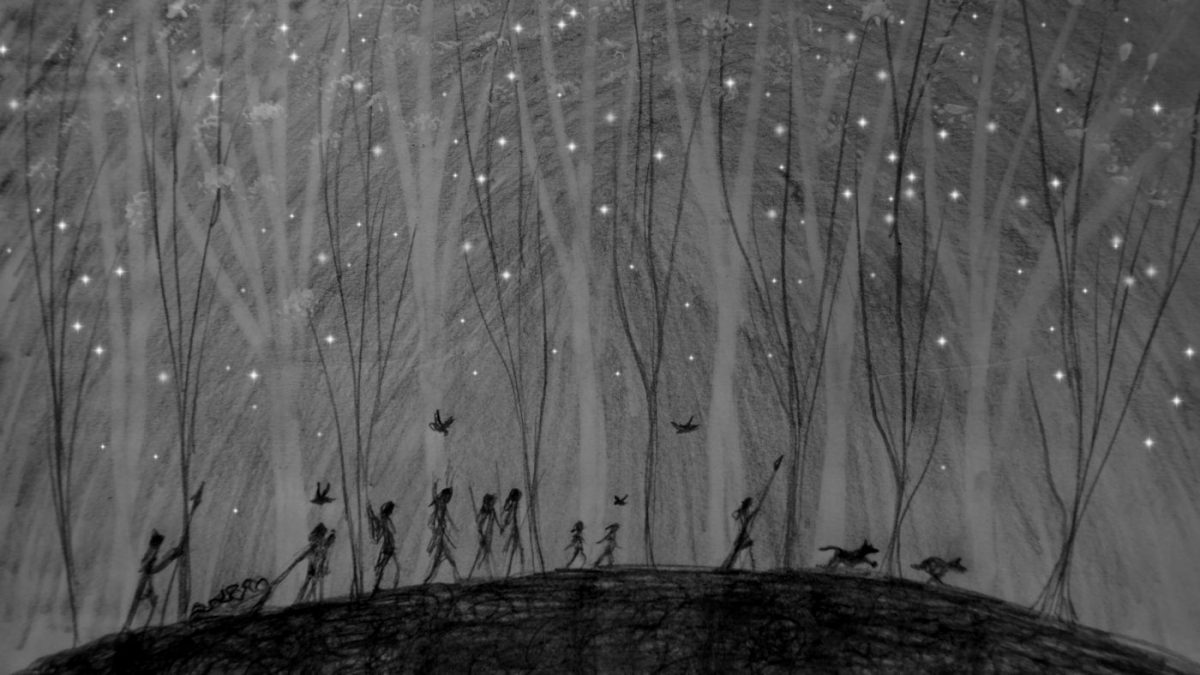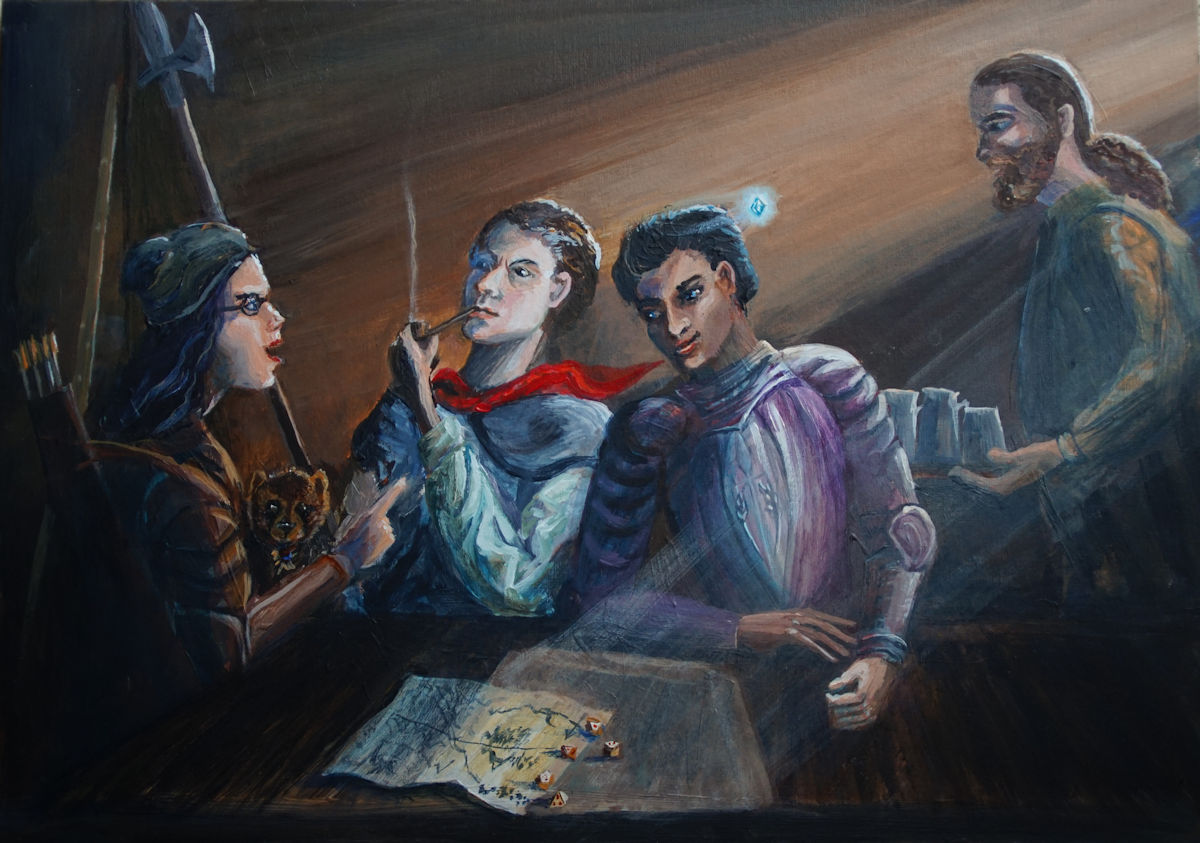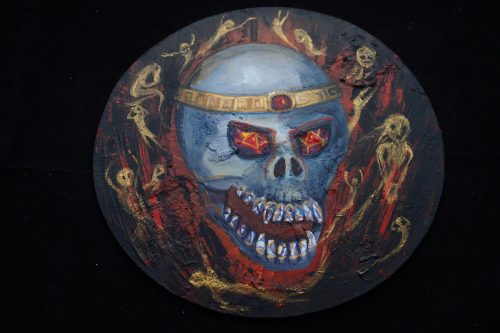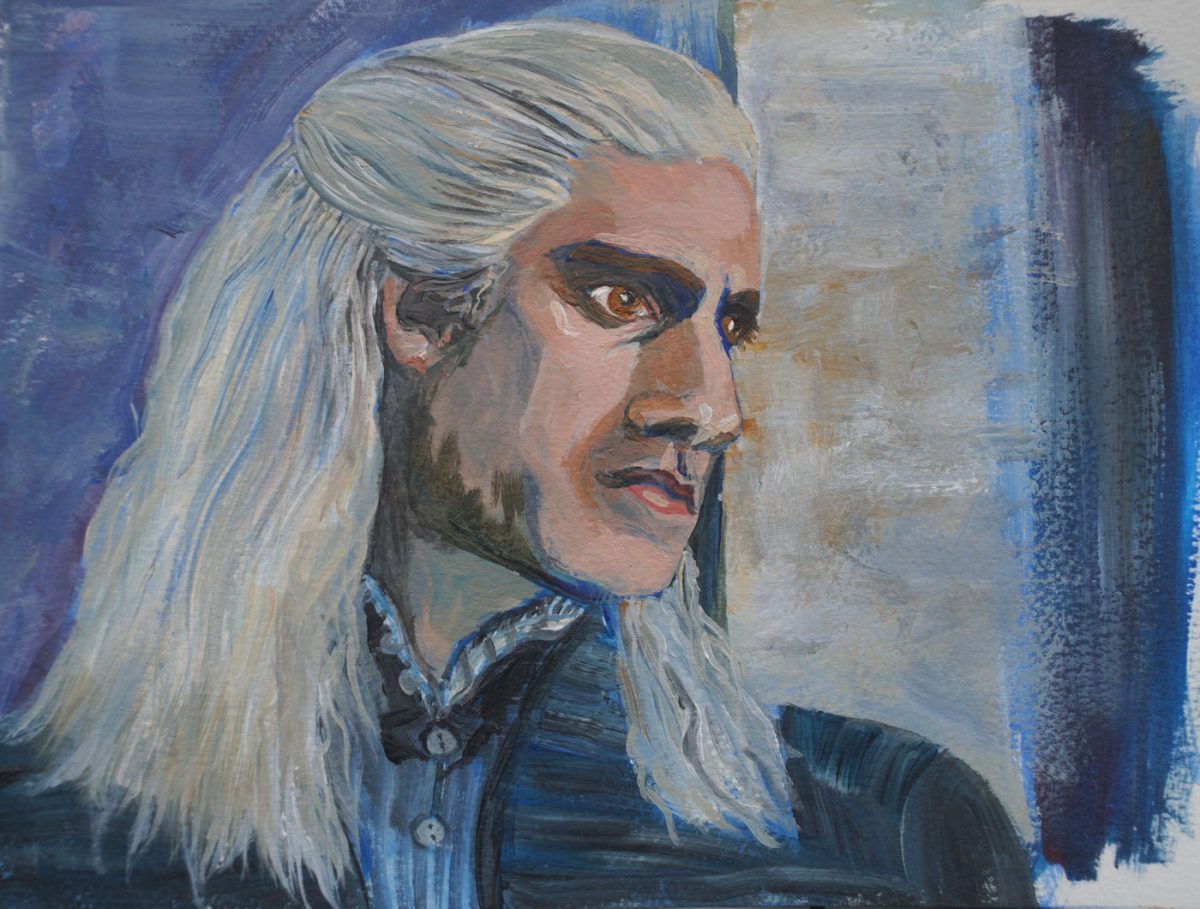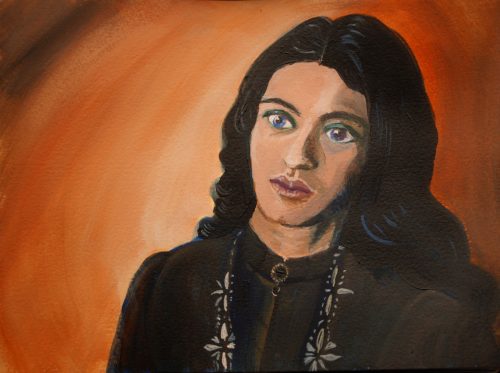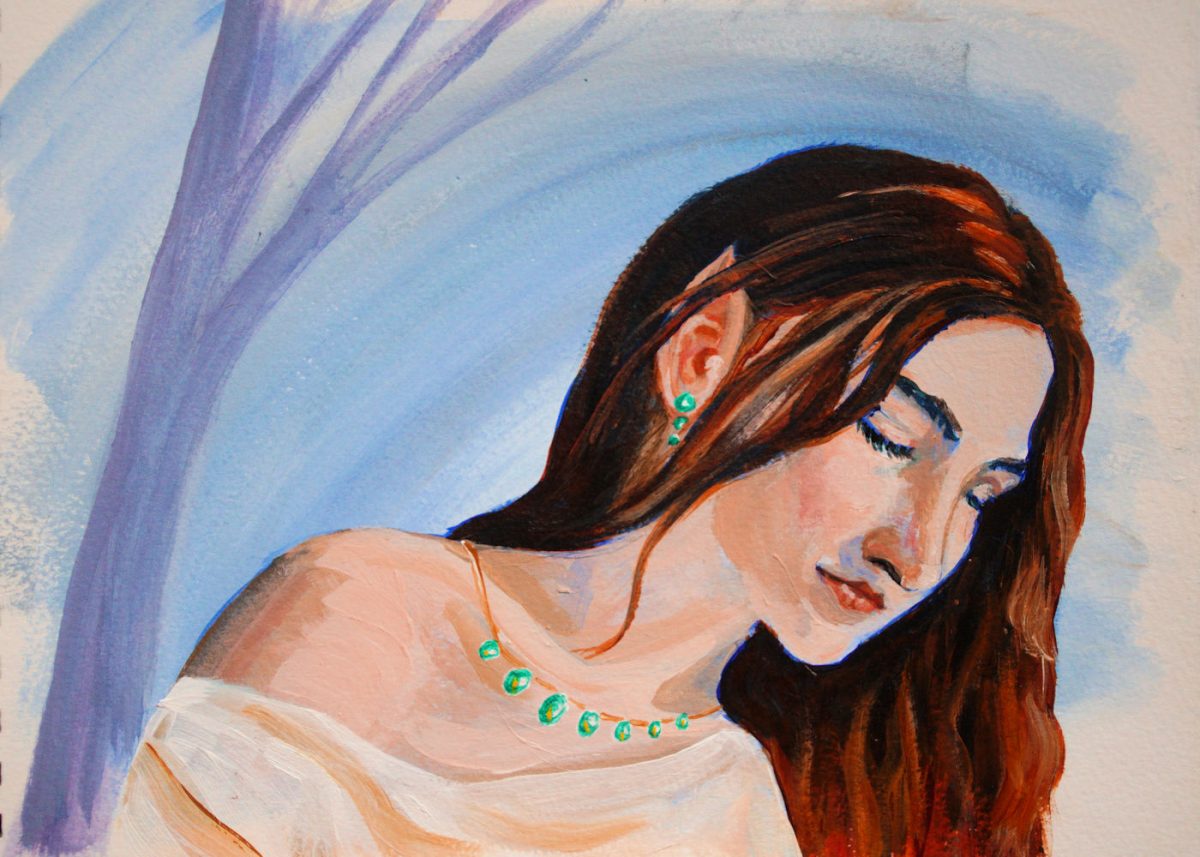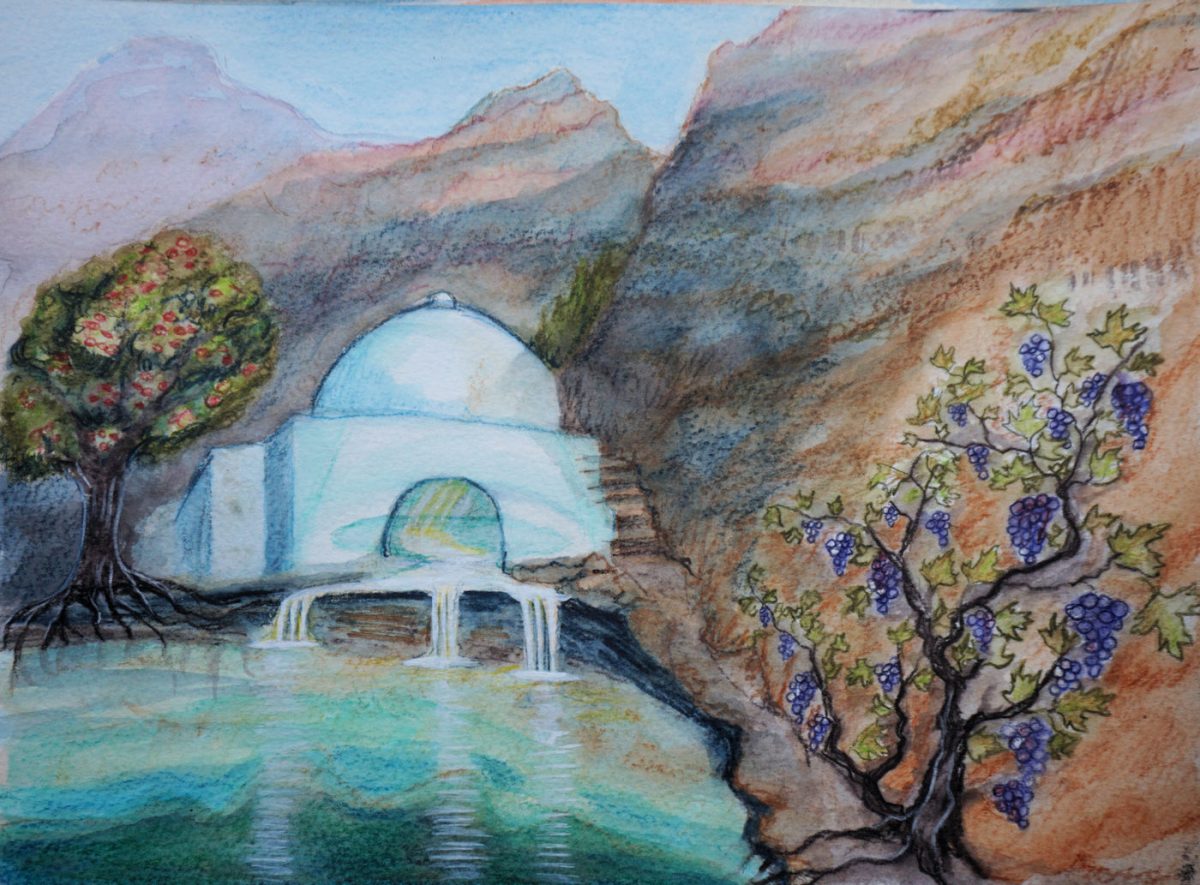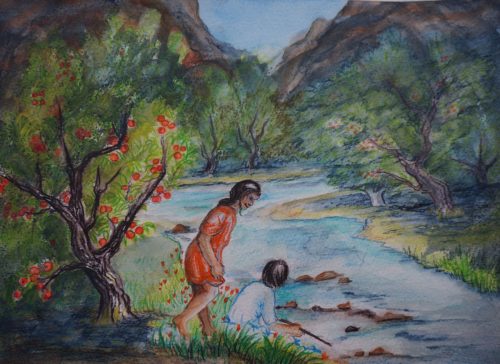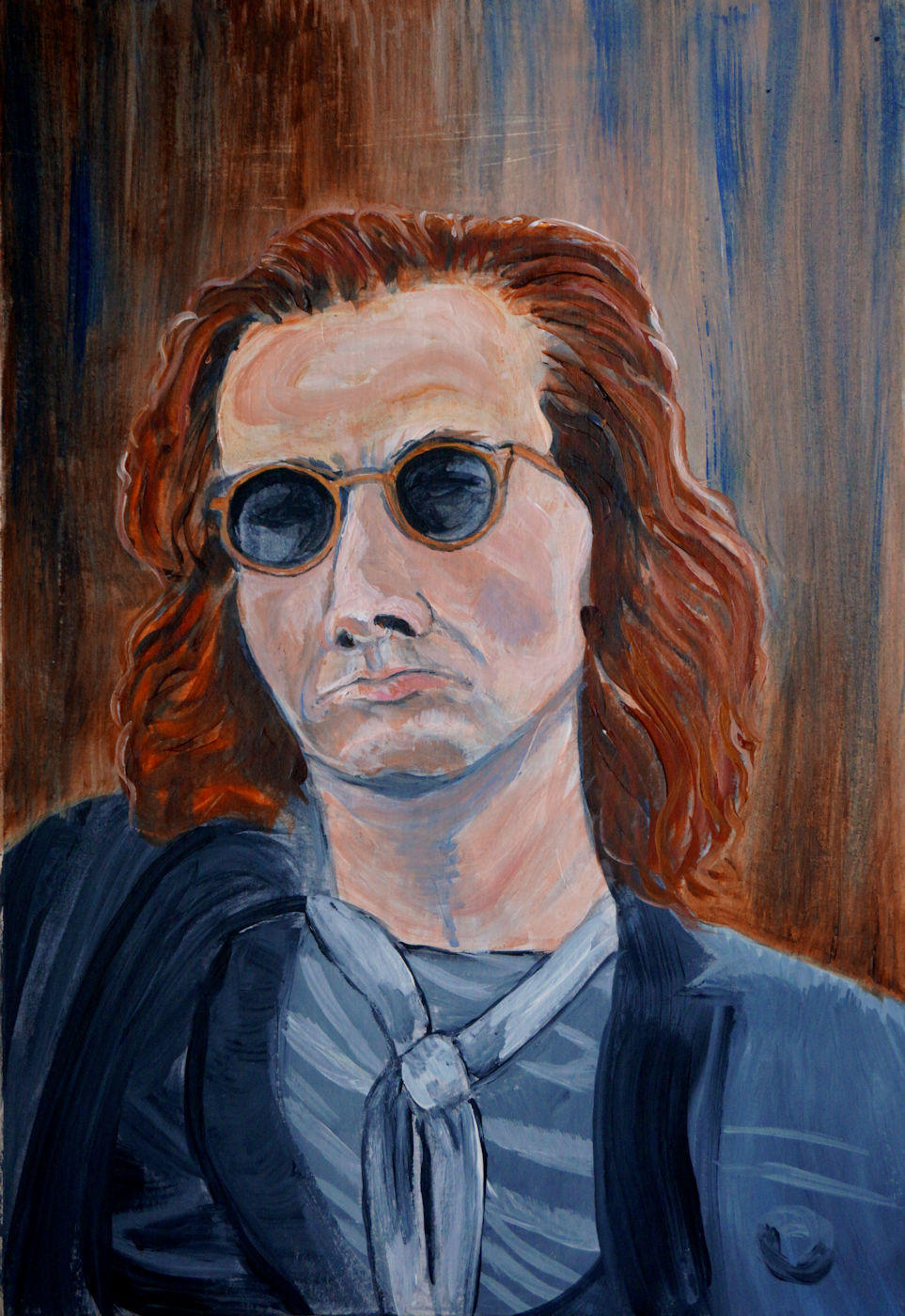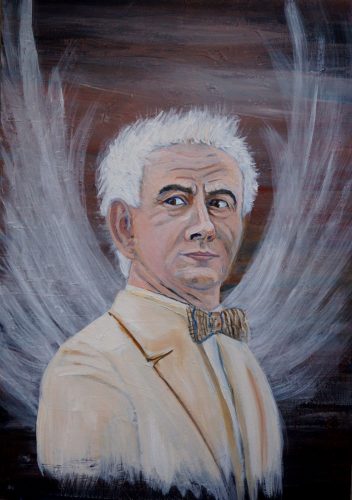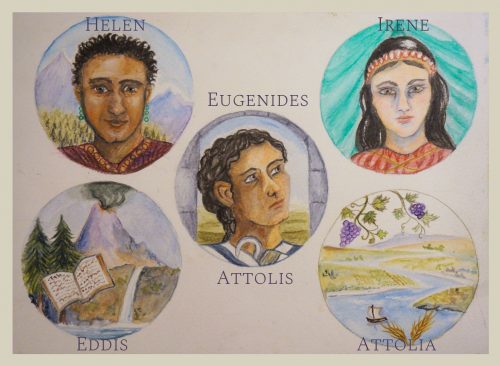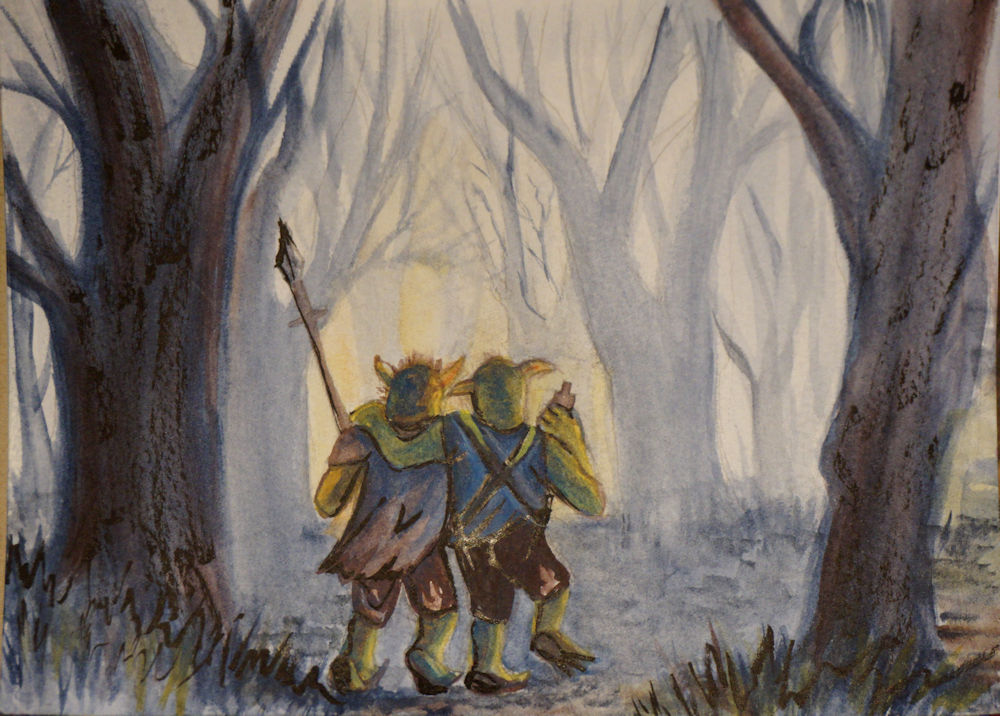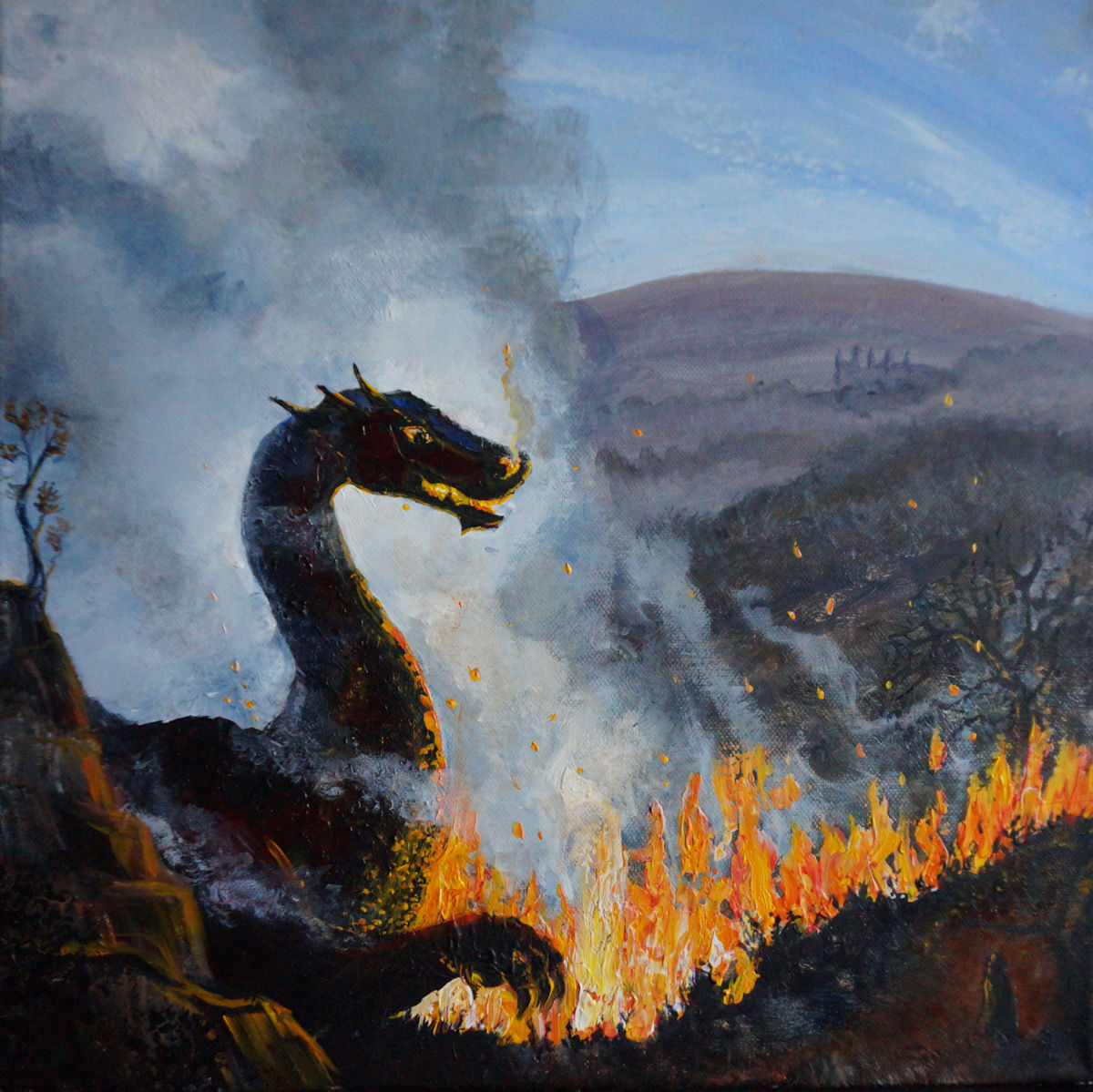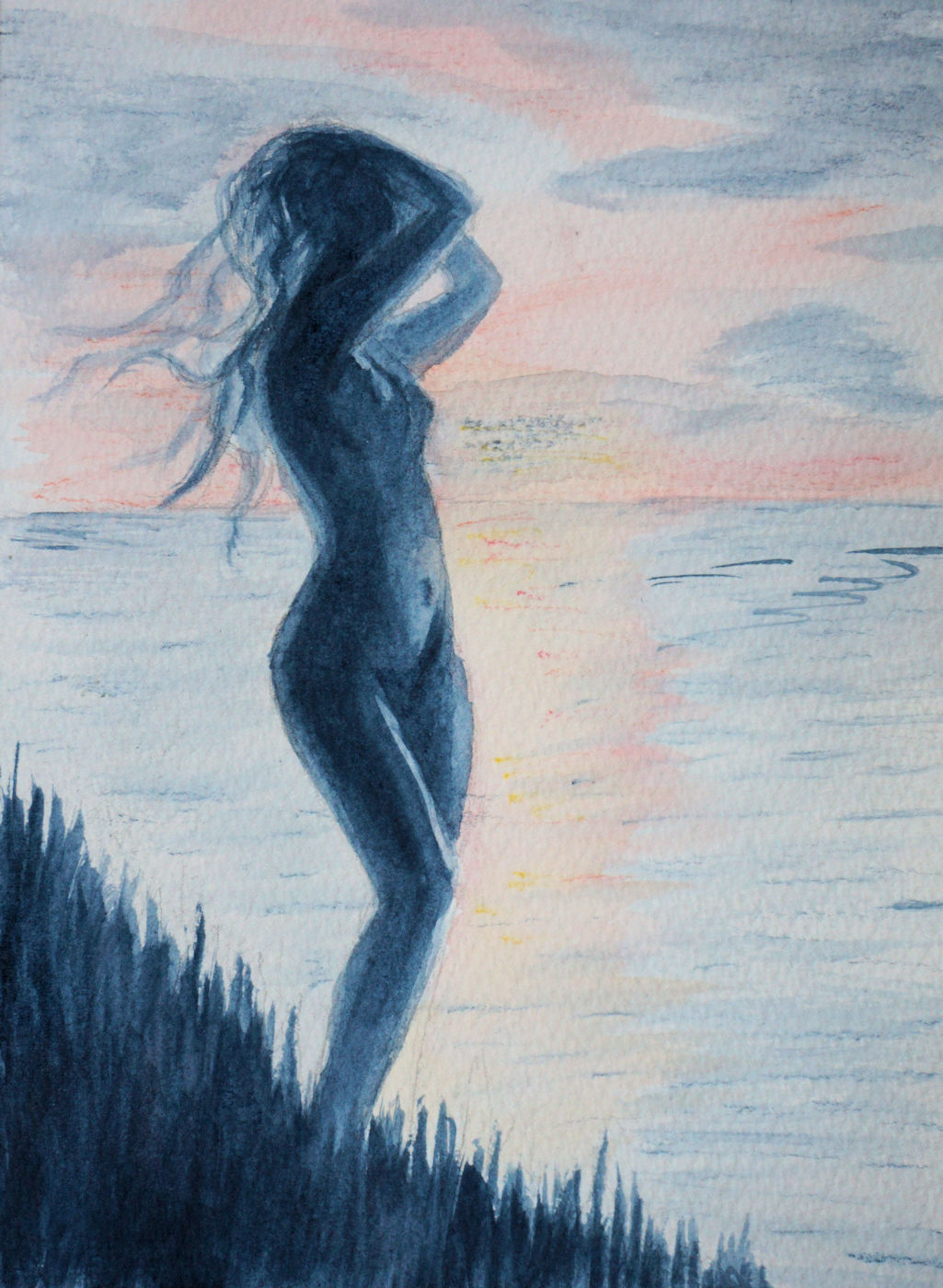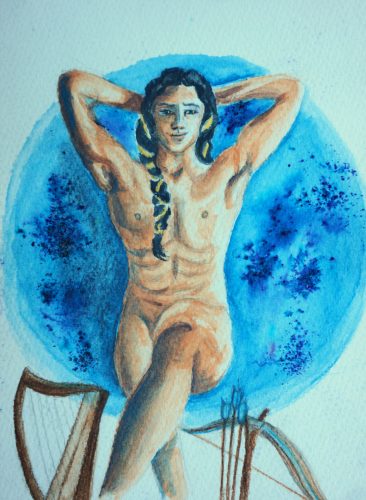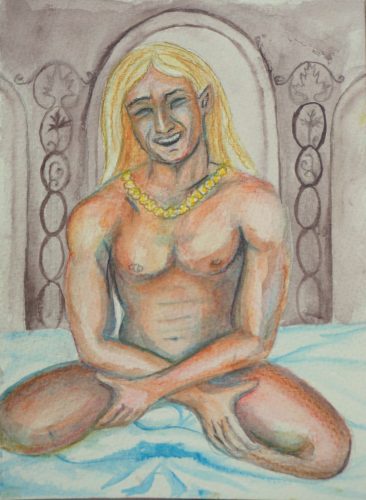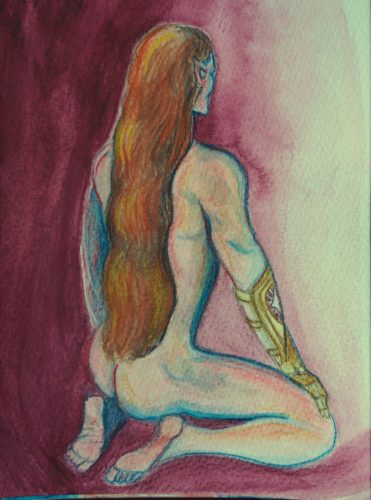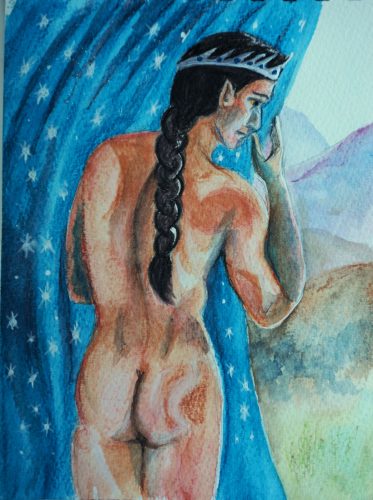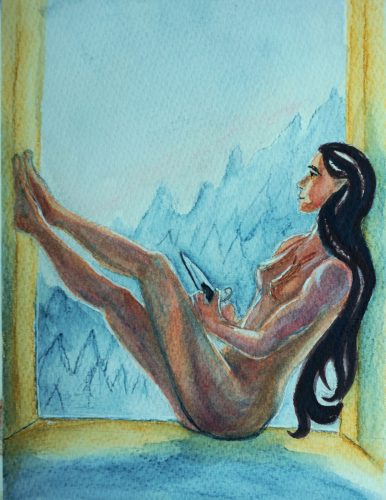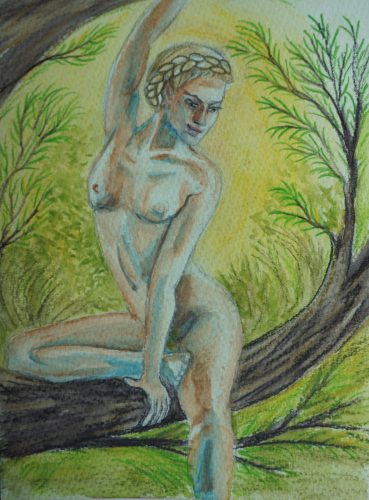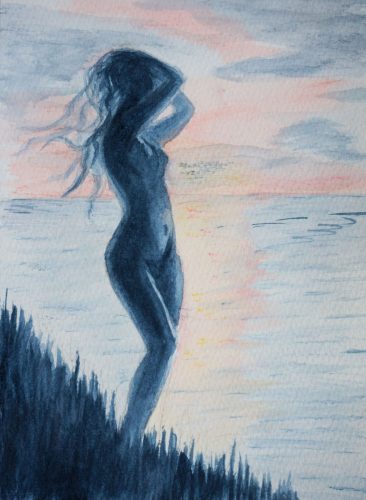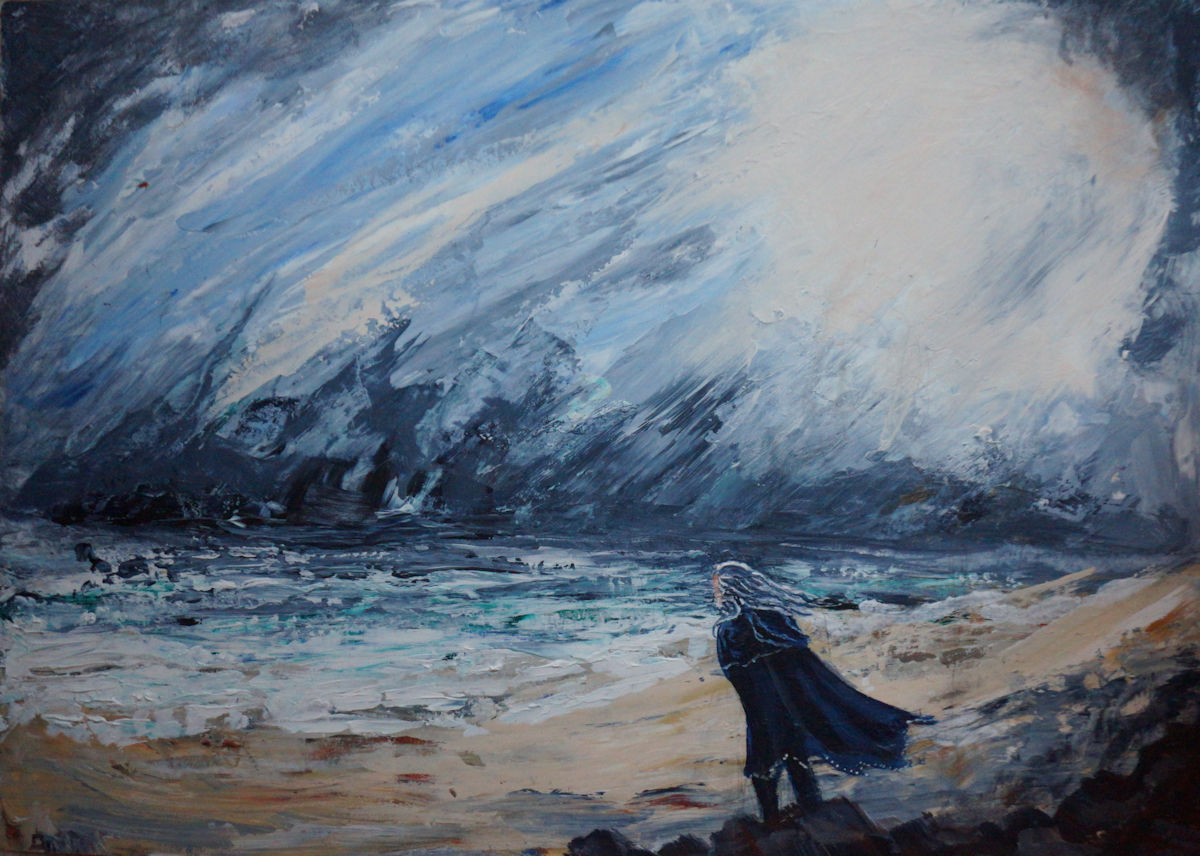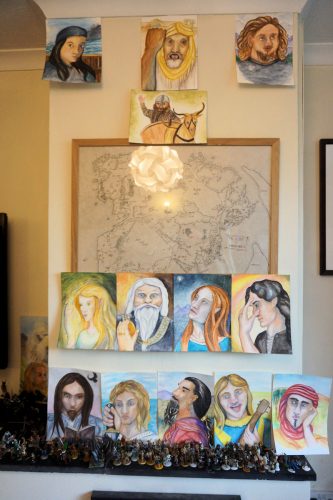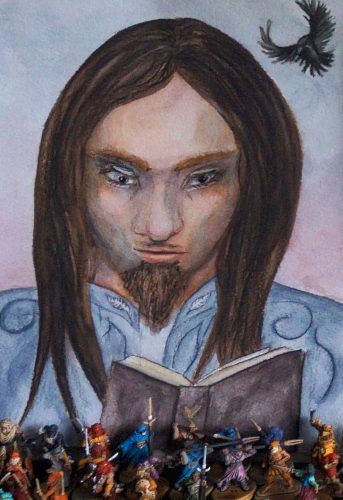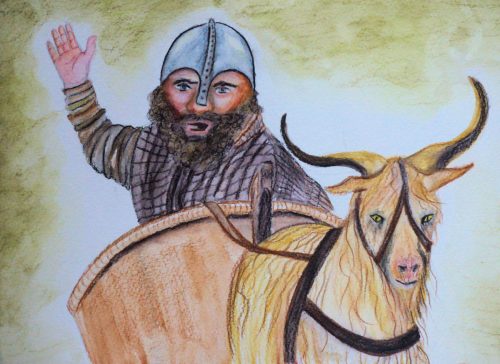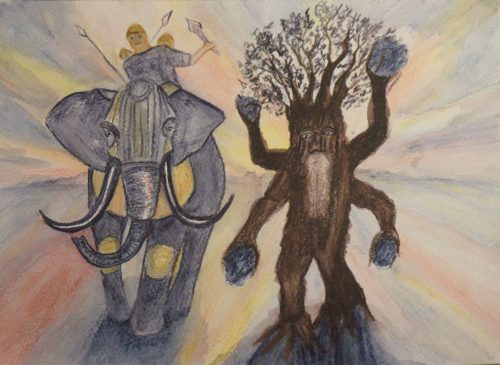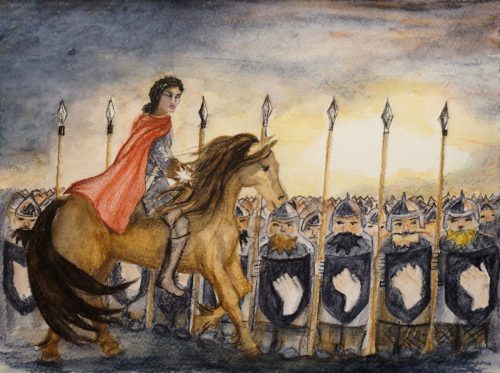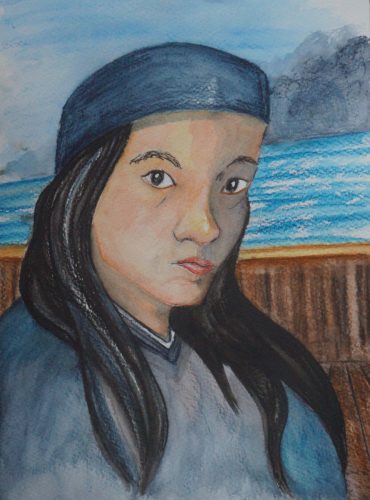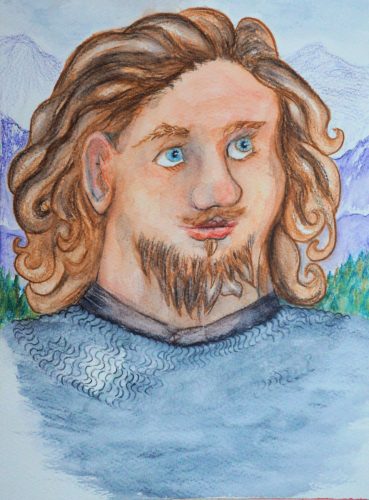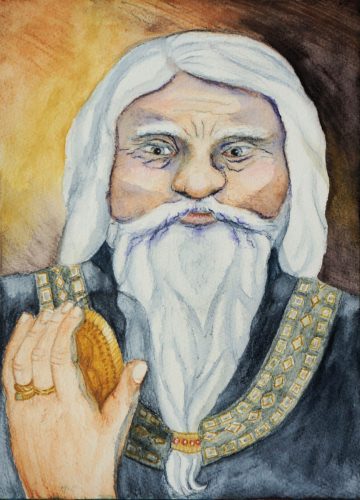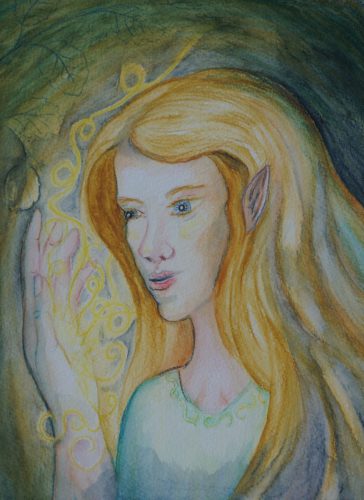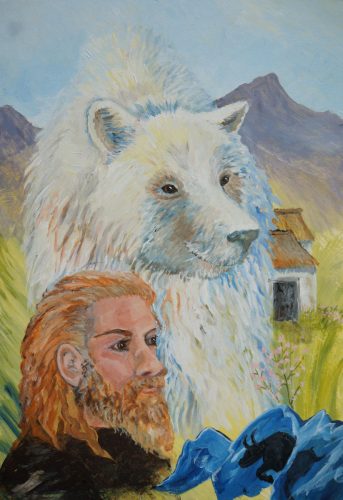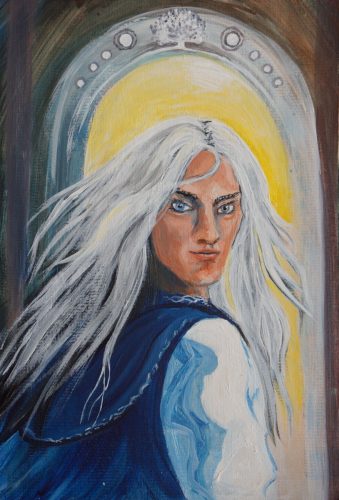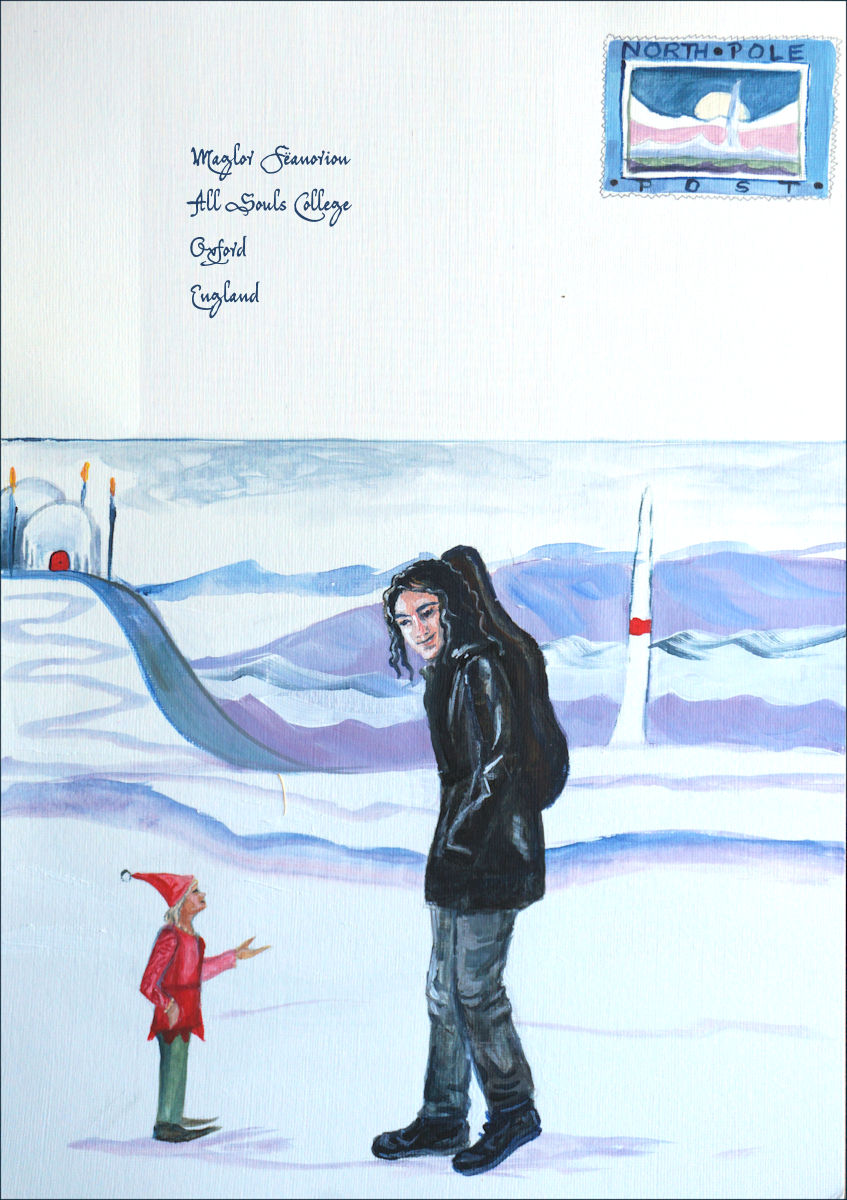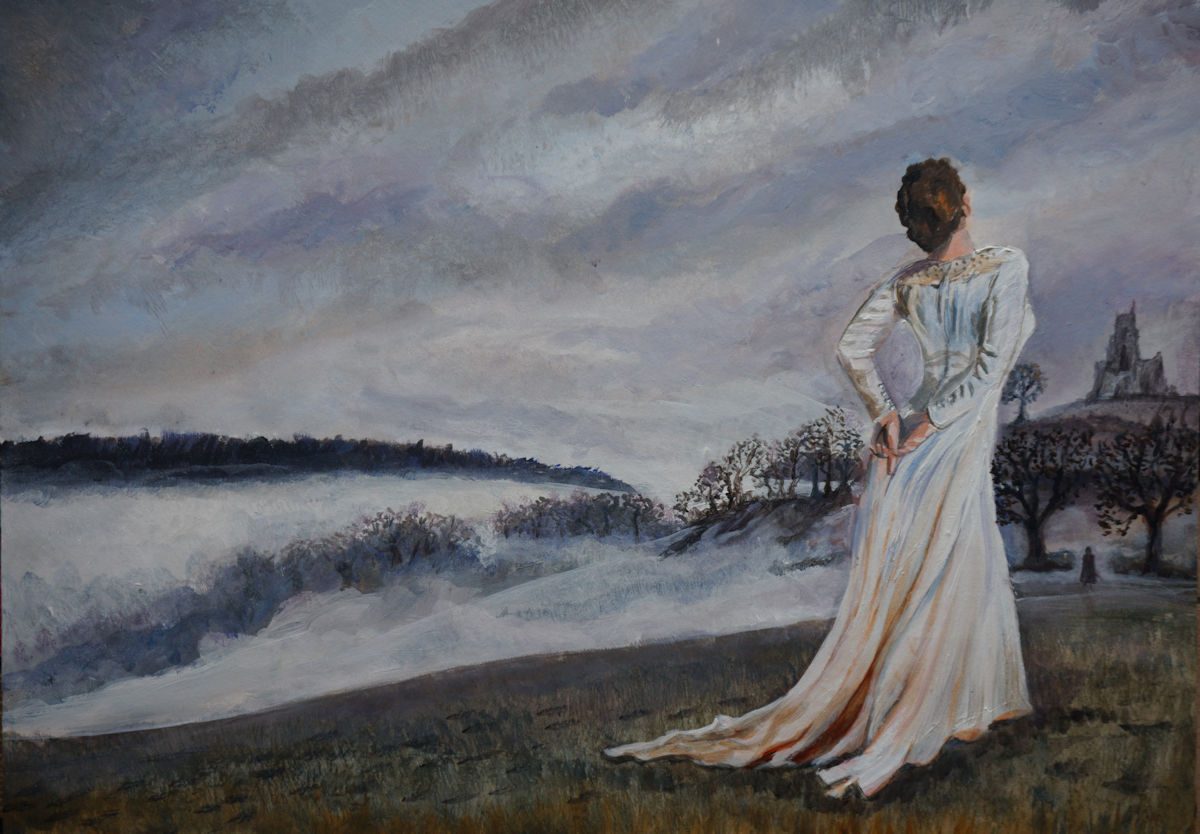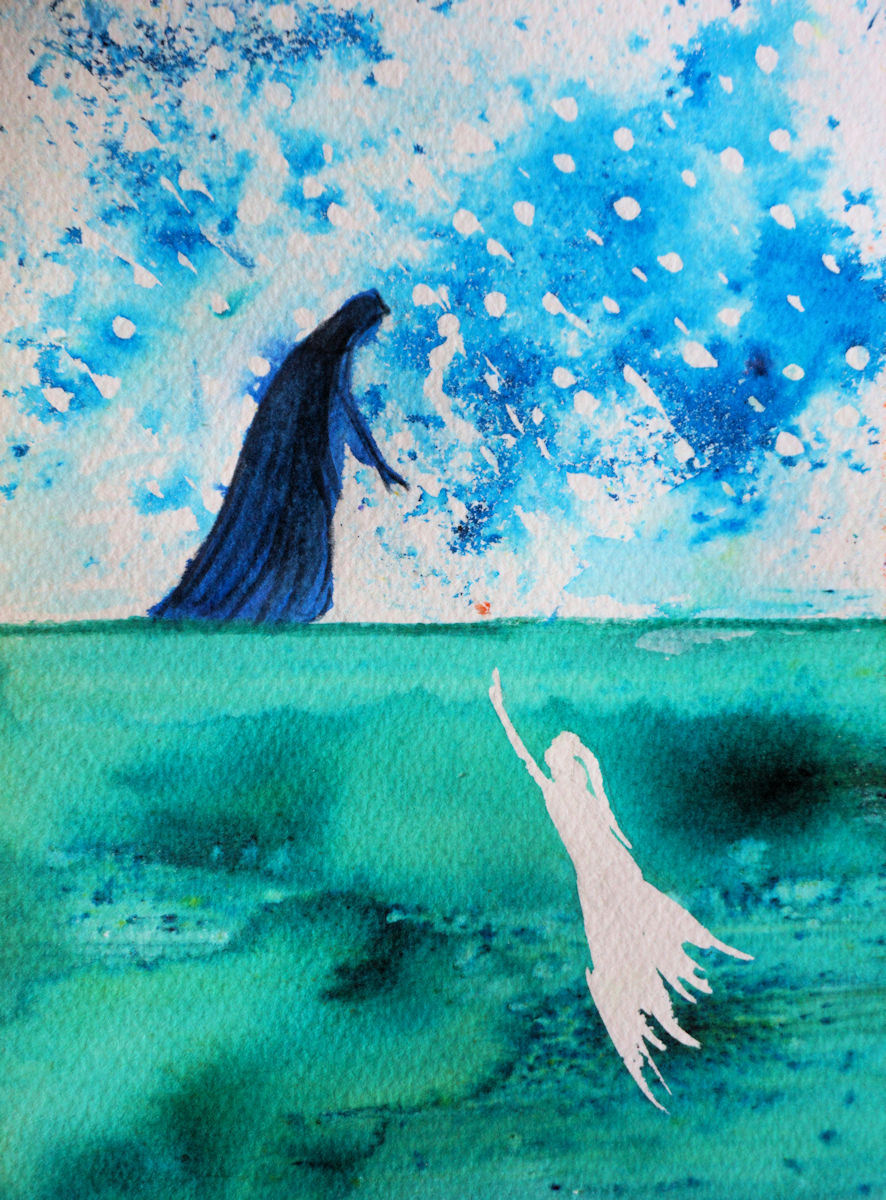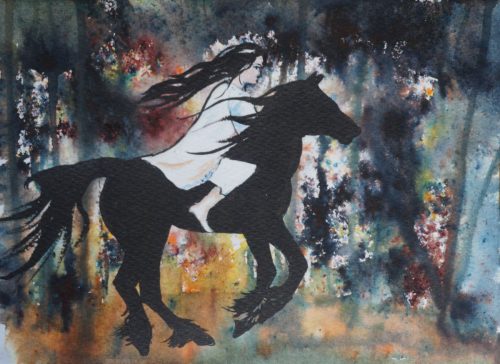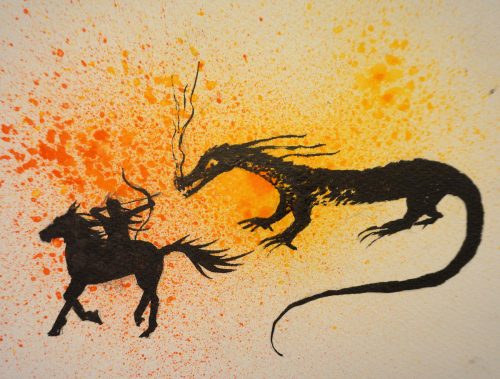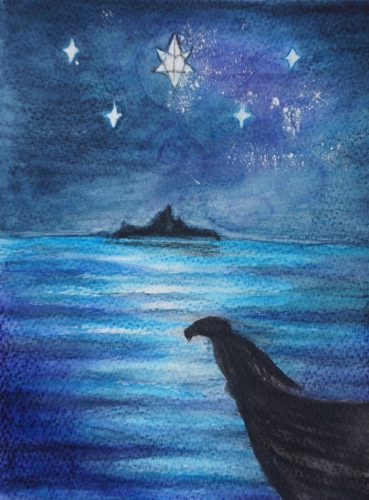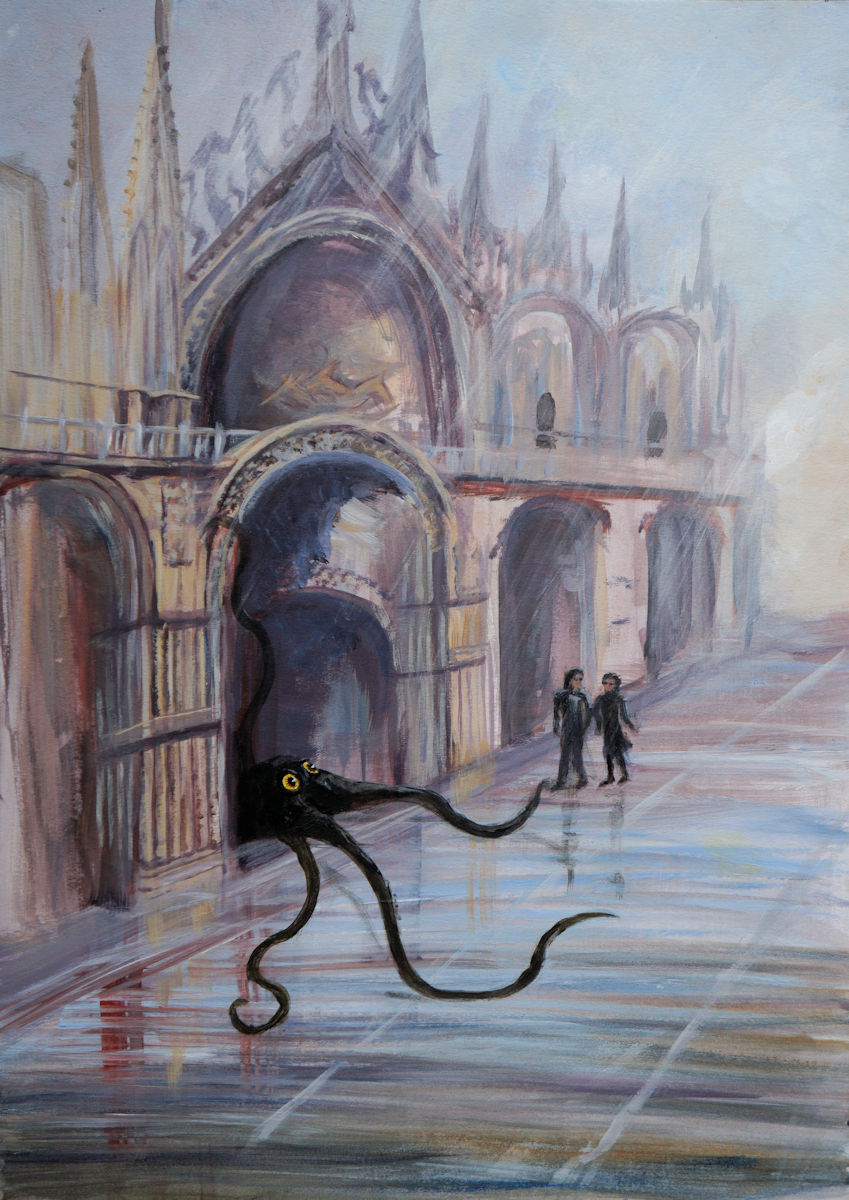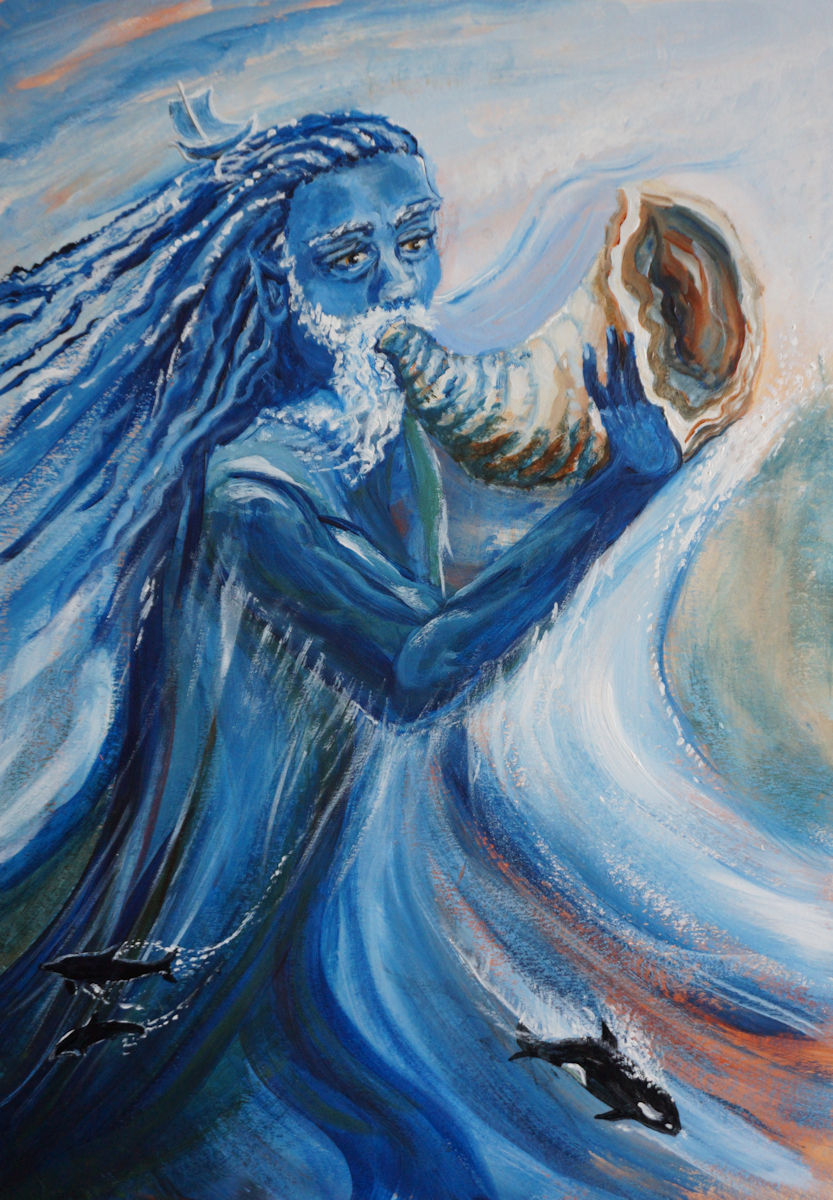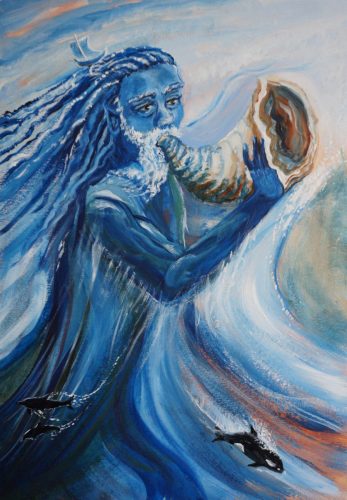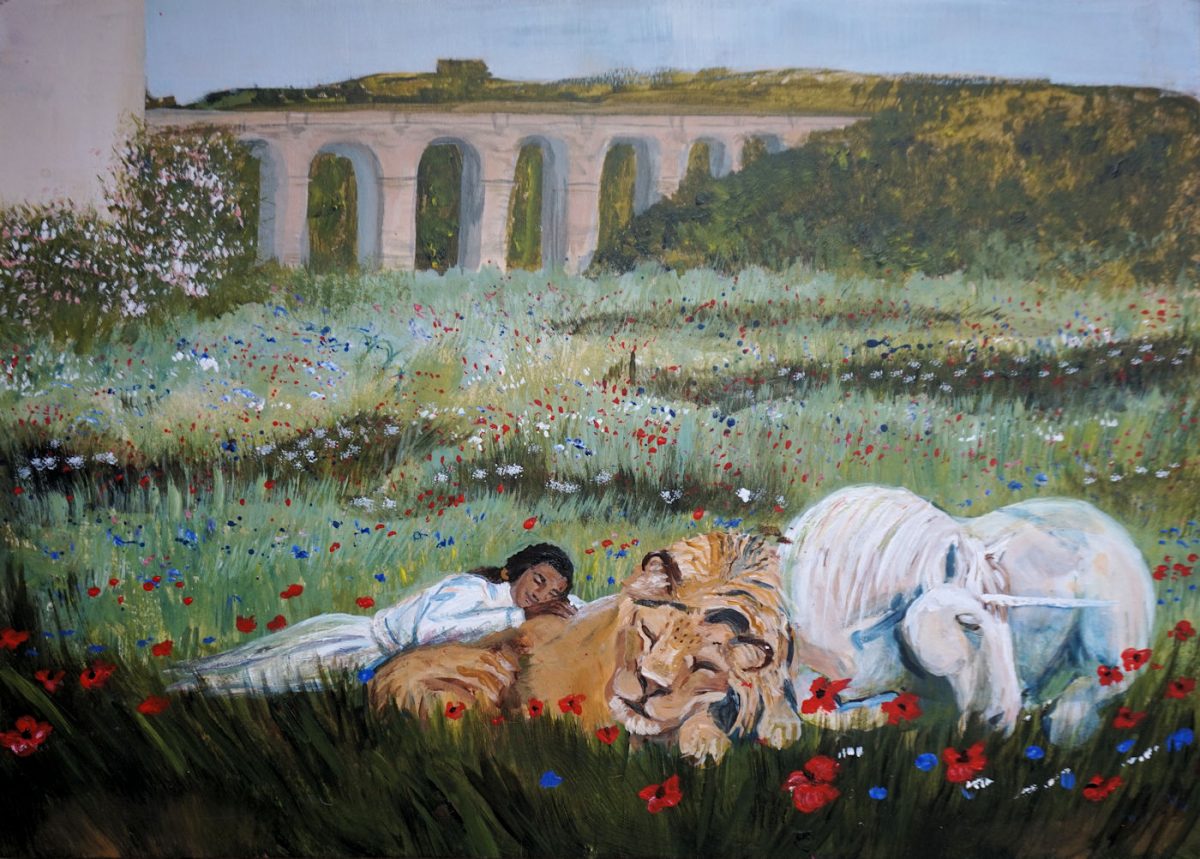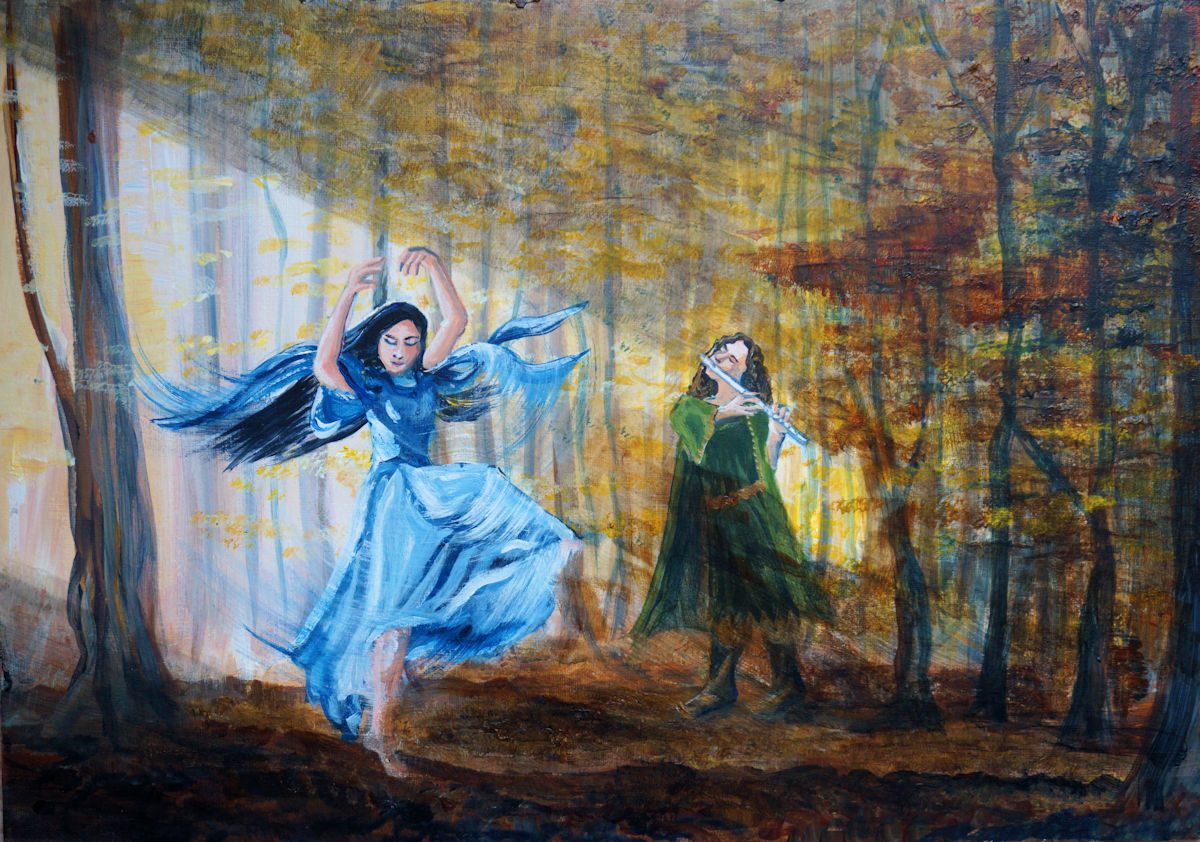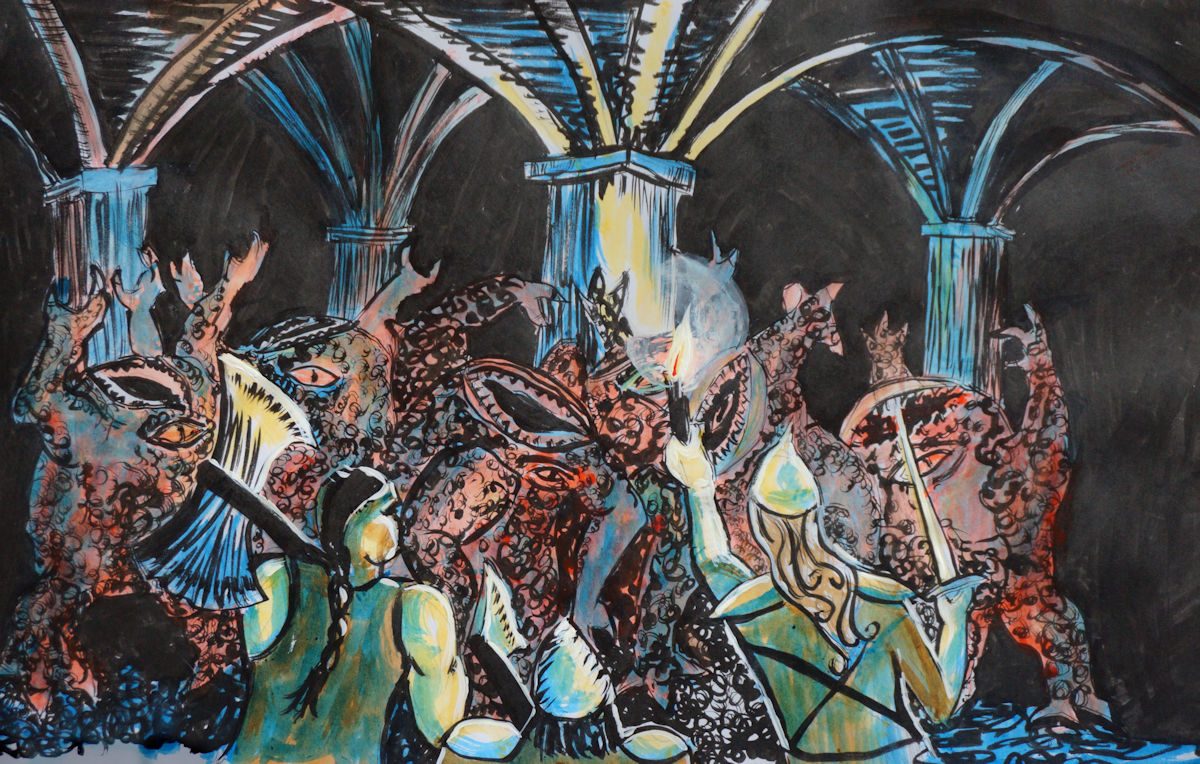A little pencil drawing of a group of Elves wandering ‘amid the world of woven trees’ with the stars overhead showing through the branches.
Category: Tolkien & Fantasy Art
Commission: Adventuring Party at Leisure
Completed version of this commissioned painting of a D&D party: first the quick A4 sketch: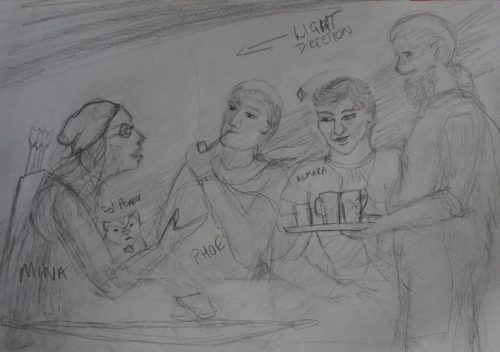
And then the final painted version: I’m told the adventurers are pleased with it. The Innkeeper on the right is based on the GM (Game Master), who commissioned the painting and was lovely to work with. 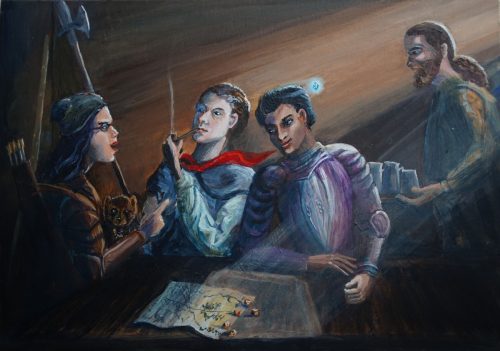 As you may have guessed, the lighting and composition was inspired by Caravaggio’s wonderful painting, The Calling of St Matthew: I thought I might as well aim high. But this little painting is just A3 in size, whereas Caravaggio’s original is about three meters square!
As you may have guessed, the lighting and composition was inspired by Caravaggio’s wonderful painting, The Calling of St Matthew: I thought I might as well aim high. But this little painting is just A3 in size, whereas Caravaggio’s original is about three meters square!
With commissioned paintings, I would usually discuss ideas with you, then email you a photo of a rough sketch, then later, email a small first-draft incomplete painted version for discussion, and then finally a completed high resolution image.
I am open to making paintings that are only supplied digitally, if you want art to print out yourself and don’t want a physical copy. However, in this case, the person who commissioned the painting did want the original as well as the photo, so it was sent out to them by post.
Demilich, Beholder : Fun with D&D Monsters!
Upcycled Demilich! This round board came to The Shop on the Borderlands as the base for a rather tired bunch of very old miniature figures.
The figures were removed & stripped of their old paint, and I have made this painting on the base. I kept the bumpy texture, which has interacted interestingly with my palette knife, and I’ve used a semitransparent gold paint to pick out details and add the ghosts of adventurers trapped by dark enchantments. The ghosts change in visibility as the light moves. Quite pleased with the flame-ruby eyes.
And here’s another famous D&D monster: a Beholder, with dagger-teeth and many eyes. I painted this because I wanted to practice painting flamelit flesh tones, and was tired of painting human figures. 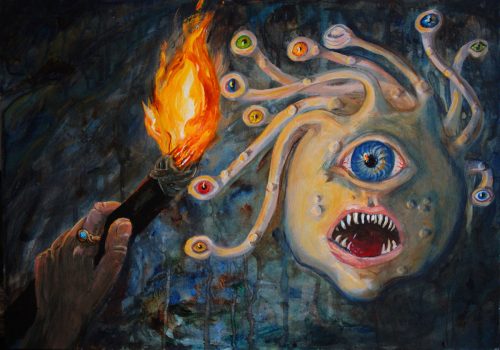 I’m particularly pleased with the ring on the adventurer’s finger.
I’m particularly pleased with the ring on the adventurer’s finger.
Geralt & Yennefer: Portraits from ‘The Witcher’
A4 acrylic portrait of an Elven Lady
I think this is another Silmarillion character: one of Mahtan’s sisters, Nerdanel’s aunts. She has a number of names, but most people call her Sarezelle, for her love of green stones. She is one of the elves who sometime takes the things made by the friends of Aule to market in Tirion, but she’s more of a thinker than a maker herself.
Three illustrations for a poem
My poet friend Pete Clark sent me his tragic fantasy poem The Well, wondering if I might feel inspired to make some art for it. Did I ever! It’s got some fabulous vivid imagery and so I dived into making these three watercolours with enthusiasm. I think the one above is probably my favorite, but all three were a lot of fun to make.
We had some discussion about what the setting should be like. I felt that the setting seemed Eastern Mediterranean, but the contrast of shining blue streams in a valley with red rock mountains reminded me of photos I’d seen of the Little Colorado River. This was what I ended up with:
And then this painting of the two protagonists of the poem is of course inspired partially by the ancient Roman statue known as the Dying Gaul (a copy of a lost Greek original). 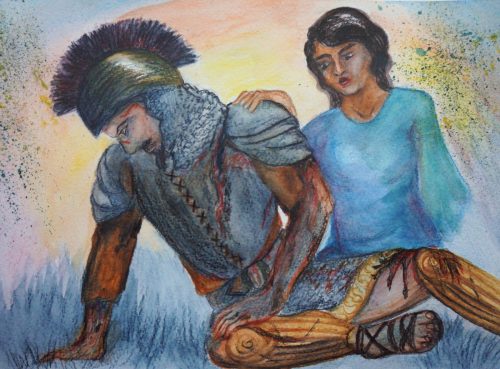
Do go to Pete’s site to read the entire poem to see the context. The Well.
Good Omens & Queen’s Thief portraits.
I wanted to practice some portraits, so here is an A4 portrait of Crowley, played by David Tennant, in Good Omens. I’ve loved the book of Good Omens by Terry Pratchett and Neil Gaiman for many years, and it was a delight to see it brought so faithfully to life on the screen. Below, Michael Sheen as Aziraphale. These two are both acrylic paintings.
Another much-beloved book – well, series of books, really, is Megan Whalen Turner’s Queen’s Thief series (I’m eagerly looking forward to the last book!) So here we have Helen, Queen of Eddis, with her short curly hair, dark skin and broken nose, set against the mountains of Eddis. Irene, Queen of Attolia, with her pale sad beauty, and her land rich with grapes and grain, and in the middle, the Queen’s Thief himself, Gen (Eugenides) who will marry Irene and become Attolis, the King of Attolia.
These are inktense pencil watercolours, apart from Helen’s face, which I made a horrible mess of on the first attempt and had to re-paint over the top using acrylic paint.
A couple of small Goblin paintings
These are small A5 paintings in inktense watercolour pencil and ink. I think the goblins staggering home after a good night out have worked pretty well, but the painting below was supposed to be a goblin too, and most people seem to think she has a bit more of a werewolf air about her. I like her anyway! 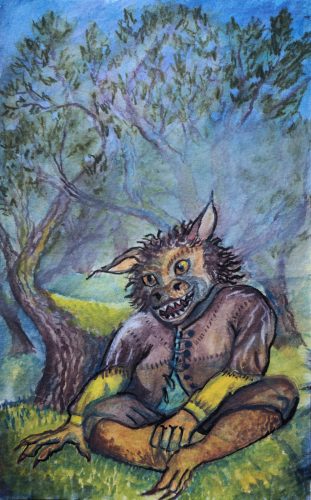
Dragonfire and ruin
I wanted to practice painting fire and smoke, and for me, that also means DRAGON! I’m not sure yet who the small figure mysteriously watching it all is: dragon-friend or enemy or simply spectator.
Selection of figure studies
Cirdan Facing the Storm
Here is Tolkien’s Cirdan the Shipwright, looking out across a wild sea into the uttermost West. Cirdan was eager to travel to Valinor; when the Teleri went without him, he wanted to sail after them, but was told to wait. He built ships for other people till the last ship sailed from Mithlond.
I made this acrylic painting after watching a demonstration by Emma Carter Bromfield at a Tavistock Group of Artists meeting this week.
A Good Many Roleplaying Character Portraits
I’ve been playing in a roleplaying campaign for five years now, run by my husband, and set in the world of Second Age Middle-earth. One great thing about roleplaying is that you meet lots of fascinating characters and get ideas for all kinds of exciting scenes. Some of these were painted in advance, but most of them were made pretty quickly during the actual campaign time, with the players giving their own ideas of what the characters should look like.
These are almost all A4 paintings, watercolour inktense pencil on watercolour paper, though the two bottom right are larger and were painted in acrylic on artcard.
Story Illustrations in acrylic and ink
Maglor from the Silmarillion meets Ilbereth, Father Christmas’s secretary from Tolkien’s Father Christmas Letters. Created for the Tolkien Reverse Summer Bang 2019 event, this work inspired this fabulous story by Narya-flame. This one is acrylic
And here’s a second illustration of Maglor on Magdalen Bridge – this time in ink with inktense pencil colour.
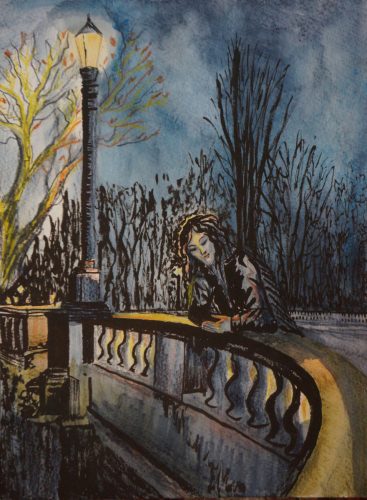
I made a brief video of the last painting by photographing it as I went along!
Lady of the Mists
I made this painting to practice painting mists, and also folded fabric, but I rather like the result!
The figure is taken from a stock photo by Marcus Ranum, the landscape is one I photographed in the Tamar Valley, and the general idea was inspired by the Ravenloft setting for D&D.
Some little ink and brusho Silmarillion-inspired paintings
Here are some ink and Brusho paintings of Silmarillion characters that I made for Nolofinwean Week on Tumblr. These are quite small paintings on A5 watercolour paper, so not quite as detailed as my larger acrylic paintings.
Aredhel riding fearless through the dark forest of Nan Dungortheb:
Fingon fighting off a rather goofy-looking Glaurung (a wingless dragon, of course):
Love Across the Ice:
Turgon & his wife Elenwe, who died crossing the Grinding Ice:
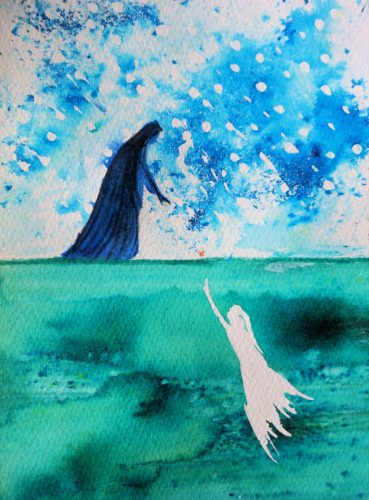
Survivors in the War of Wrath:
In the Halls of Mandos as the War of Wrath raged across Beleriand, Fingolfin Fingon, Angrod, Aegnor and Aredhel found this tapestry: Fingolfin’s wife Anaire in battle beside their cousin Galadriel. Now they can’t decide whether to cheer or bite their imaginary spirit-nails. There were not so many Noldor who survived Beleriand, and yet they sent a host to the War of Wrath: I believe that host was largely made up of the women who did not follow Feanor and Fingolfin.
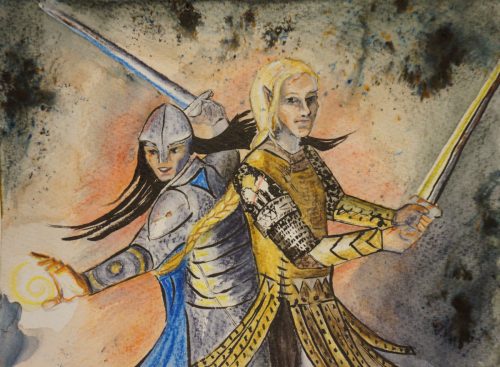
Eärendil’s Star:
Elros’s father, guiding Elros’s ship, with an Eagle figurehead, towards the Land of Gift, Numenor.
Visitors in Venice
This painting of St Mark’s basilica in Venice was an exercise in painting misty buildings. I decided it would be better with tentacles.
Lord of the Sea
Ulmo, Lord of the Sea, playing one of his great horns. I painted this very fast – it is A3, but I completed it in about 3 hours, and I was trying for a free style with lots of movement. Of course it looks better in real life than in the photo, but I’m still quite pleased with this one at the moment.
The Lion and the Unicorn (and friend)
There are some marvellous wildflowers around at this time of year. I’m not sure why I decided that the perfect figures to set them off would be a lion, a unicorn and a sleepy human, but I did.
Experiments in Lighting Lúthien Tinúviel
I’ve painted Tolkien’s heroine Lúthien Tinúviel before, but this time instead of painting her dancing in spring among the hemlock-flowers, I decided to go for an autumnal scene suggested by this verse:
He heard there oft the flying sound
Of feet as light as linden-leaves,
Or music welling underground,
In hidden hollows quavering.
Now withered lay the hemlock-sheaves,
And one by one with sighing sound
Whispering fell the beachen leaves
In the wintry woodland wavering.
This was my first version of the painting:
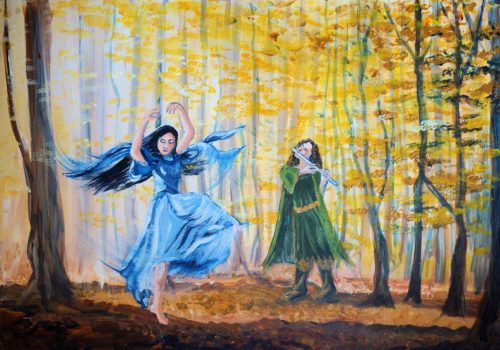
But I felt that it was a little over-bright, and since I happened to be photographing it in the afternoon, I wondered how it would look if I moved it into the light of a directional sunbeam coming in through an open door. It looked like this:
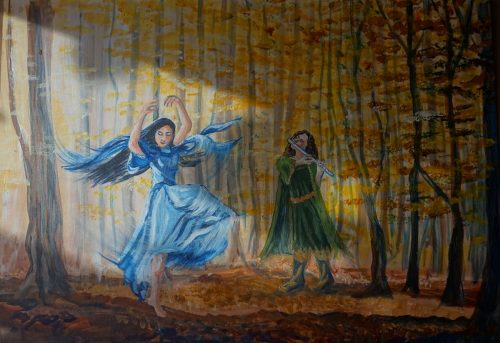
I decided, having looked at it for a bit, that I really liked the lighting, so I gave the painting a dark glaze to replicate the effect: this is the same painting, photographed this time in a dull north light, but painted to show the sunbeam.
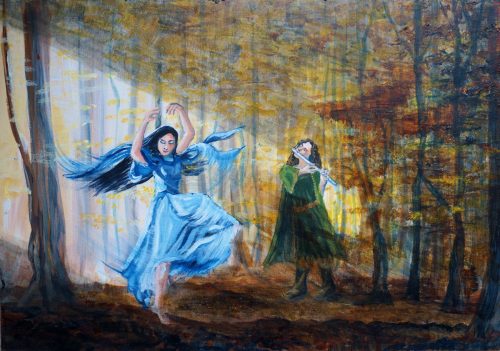
A dangerous dungeon!
This pen and watercolour A4 sketch was made for the Shop on the Borderlands. It shows an adventuring party meeting a great group of ferocious Xorn. I was deliberately trying for an old-fashioned role-playing -game look and feel here, and I’m told this meets the brief pretty accurately!

